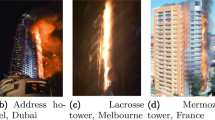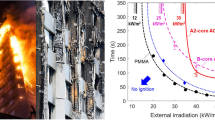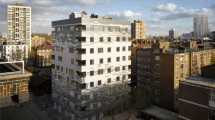Abstract
Facade systems used in modern buildings have received much attention in recent times due to their involvement in the propagation of fires in various incidents. These systems comprise of multiple components—cladding frame (typically of aluminum), façade panels (glass, aluminum composite panels, etc.), perimeter firestop (to seal the gap between floor and façade) and spandrel fire protection (typically provided from the inside of a compartment). While many standardized testing methods exist for quantifying their fire performance, most of them consider the behavior of individual components in isolation. The test conditions are also quite different from those encountered in real fire scenarios. The current study highlights these gaps and provides inferences from six full-scale real fire experiments conducted in a three-storey structure with different façade (curtain wall) and firestop configurations. Combustible façade panels of aluminum composite panels (ACP) and medium density fiberboard (MDF) and non-combustible glass panels of single glazed units and double-glazed units were utilized whereas two different methods of edge of the slab firestop and spandrel insulation were employed. The fire scenarios were developed at all floor levels (fire loads as well as initial ventilation conditions) as per realistic residential/office type dwellings. It was found that once the flames leap out of the fire compartment due to the failure of the façade panels, the spandrel area was subjected to 31 kW/m2 of additional heat flux, which indicated the need to consider fire protection of the spandrel area from the outside, especially for combustible façade systems. Further, one of the firestop installation methods was found to be more robust to address site tolerances and installation uncertainties arising due to workmanship as it allowed significantly less ingress of hot gases and toxic fumes to the upper floors. In terms of the two combustible panels, ACP and MDF, it was found that there were differences in their performance in a bench-scale experiment (cone calorimeter) and the full-scale experiments. MDF was found to perform better in the full-scale experiments. The method used for securement of the façade panels (pressure tape/silicone sealant and screws) was also found to have significant effect on the overall performance of the façade system; the failure mechanism of the façade panels was found to be different in both cases. It is expected that the findings presented in this study will provide insights to the real performance of different façade components as a system and will help in improving the codes and standards in the future.

















Similar content being viewed by others
References
Carbary LD, Yee S, Bagatelos N (2014) Architectural insulation modules: thermal and structural performance for use in curtainwall construction.
Klee C and Love A (2014) Thermal performance of façades. Boston, USA.
Badrock G (2016) Post incident analysis report: Lacrosse Docklands, 25 November 2014. In: MATEC Web of conferences, vol 46, p 06002. https://doi.org/10.1051/matecconf/20164606002
Martin M-B (2019) Grenfell tower inquiry: phase 1 report. Ministry of Housing Communities & Local Government, UK
Gandhi P et al (2017) Performance of glass-ACP façade system in a full-scale real fire test in a G+2 structure. Procedia Eng 210:512–519. https://doi.org/10.1016/j.proeng.2017.11.108
Nguyen K, Weerasinghe P, Mendis P, Ngo T, Barnett J (2016) Performance of modern building façades in fire: a comprehensive review. Electron J Struct Eng 16(1):69–86
Peng L, Ni Z, Huang X (2013) Review on the fire safety of exterior wall claddings in high-rise buildings in China. Procedia Eng 62:663–670. https://doi.org/10.1016/j.proeng.2013.08.112
Nathan W, Delichatsios M (2015) Fire hazards of exterior wall assemblies containing combustible components. Springer-Verlag, New York
Routley JG (1988) Interstate Bank building fire Los Angeles, California. Technical Report, Federal Emergency Management Agency (FEMA)
Woodward J, Singh BB (2020) Firestopping everything you need to know about. International Code Council
Valiulis J, Phillips S (2006) Twelve common deficiencies found during firestopping inspections. J ASTM Int. https://doi.org/10.1520/JAI13027
Law A, Kanellopoulos G (2020) The rise and fall of the UK’s spandrel panel. Fire Saf J 115:103170. https://doi.org/10.1016/j.firesaf.2020.103170
Srivastava G, Nakrani D, Ghoroi C (2020) Performance of combustible facade systems with glass, ACP and firestops in full-scale, real fire experiments. Fire Technol 56(4):1575–1598
Bisby L (2018) Grenfell tower inquiry. Phase 1-final expert report, UK
Nishio Y et al (2016) Fire spread caused by combustible facades in Japan. Fire Technol 52(4):1081–1106. https://doi.org/10.1007/s10694-015-0535-5
Bisby L, Gales J, Maluk C (2013) A contemporary review of large-scale non-standard structural fire testing. Fire Sci Rev 2(1):1. https://doi.org/10.1186/2193-0414-2-1
Ariyanayagam AD, Mahendran M (2013) Fire safety of buildings based on realistic fire time-temperature curves. In: Proceedings of the 19th international CIB World Building Congress, Brisbane 2013: construction and society, pp. 1–13
National Building Code of India - part 4: Fire And Life Safety (2005) Standard. Bureau of Indian Standards, New Delhi
Srivastava G et al (2018) Development of a unique full-scale real-fire façade testing facility at IIT Gandhinagar. Curr Sci 115(9):1782–1787
ASTM D792–20 (2020) Standard test methods for density and specific gravity (relative density) of plastics by displacement. ASTM International, West Conshohocken, PA
“ASTM E1269 (2005) Standard test method for determining specific heat capacity by differential scanning calorimetry, West Conshohocken, PA
Li KY, Huang X, Fleischmann C, Rein G, Ji J (2014) Pyrolysis of medium-density fiberboard: optimized search for kinetics scheme and parameters via a genetic algorithm driven by Kissinger’s method. Energy Fuels 28(9):6130–6139. https://doi.org/10.1021/ef501380c
Kayacan I, Doğan ÖM (2008) Pyrolysis of low and high density polyethylene. Part I: non-isothermal pyrolysis kinetics. Energy Sources Part A 30(5):385–391. https://doi.org/10.1080/15567030701457079
Shah J, Jan MR, Mabood F, Jabeen F (2010) Catalytic pyrolysis of LDPE leads to valuable resource recovery and reduction of waste problems. Energy Convers Manage 51(12):2791–2801
“ISO 5660-1:2015 (2015) Reaction-to-fire tests—heat release, smoke production and mass loss rate—part 1: heat release rate (cone calorimeter method) and smoke production rate (dynamic measurement)
Nakrani D, Wani T, Srivastava G (2020) Simulation of pyrolysis and combustion of pine wood using two-step reaction scheme.
Larsson O (2008) Shear capacity in adhesive glass-joints. Master’s Thesis, Division of Structural Mechanics, Lund University
Bystritskaya EV, Karpukhin ON, Tsverava VG, Nepovinnykh VI, Rusin MY (2012) Thermal degradation of silicone sealant. Int Polym Sci Technol 39(7):47–51. https://doi.org/10.1177/0307174x1203900710
Majdalani AH, Cadena JE, Cowlard A, Munoz F, Torero JL (2016) Experimental characterisation of two fully-developed enclosure fire regimes. Fire Saf J 79:10–19. https://doi.org/10.1016/j.firesaf.2015.11.001
Roy A, Chawhan RS, Patel R, Varadharajan S, Tiwari LM, Chakraborty AL, Ghoroi C, Srivastava G (2019) Quantifying the CO and CO2 mole fraction in the plume of an aerosol-based fire extinguishing agent using 4560 nm and 4320 nm QCLs. IEEE Sens J 19(21):9728–9735
“EN 1991-1-2 (2002) Eurocode 1: action on structures—part 1–2: general actions on structures exposed to fire. Standard
Nagy N (2020) Determination of thermal properties of mineral wool insulation materials for use in full-scale fire modelling. Master’s thesis, Mechanical and Mechatronics Engineering, University of Waterloo, Ontario, Canada, 2020.
Holicky M, Meterna A, Sedlacek G, Schleich JB (2005) Implementation of Eurocodes, handbook 5, design of buildings for the fire situation. Luxembourg: Lenoardo da Vinci Pilot Project
Peng L, Ni Z (2006) Experimental study of window-ejected flame and plume on glass curtain walls. In: MATEC web of conferences 46, 05009, EDP Sciences
Babrauskas V (2011) Glass breakage in fires. Fire Science and Technology, Inc, pp 1–7
Hassani SK, Shields TJ, Silcock GW (1994) An experimental investigation into the behavior of glazing in enclosure fire. J Appl Fire Sci 4:303–323
Xie Q, Zhang H, Wan Y, Zhang Q, Cheng X (2008) Full-scale experimental study on crack and fallout of toughened glass with different thicknesses. Fire Mater 32:293–306
Acknowledgements
The support of this work from the Centre for Safety Engineering, Indian Institute of Technology Gandhinagar and Underwriters Laboratories is gratefully acknowledged. Partial support from Hilti India Pvt. Ltd is also acknowledged.
Author information
Authors and Affiliations
Corresponding author
Additional information
Publisher's Note
Springer Nature remains neutral with regard to jurisdictional claims in published maps and institutional affiliations.
Appendices
Appendix 1: Thermal Images of the Experiments at Selected Timeline Events
See Tables 11, 12, 13, 14, 15, and 16
Appendix 2: Location of Thermocouples in Experiments 1, 3, 4, 5, 6
2.1 Experiment 1

2.2 Experiments 3 and 4

Above and below firestop (smoke was extracted just above the locations BNHL#5 and AHL#5).
2.3 Experiments 5 and 6

Above and below firestop (smoke was extracted just above the locations BNHL#11 and AHL#11).
Rights and permissions
Springer Nature or its licensor (e.g. a society or other partner) holds exclusive rights to this article under a publishing agreement with the author(s) or other rightsholder(s); author self-archiving of the accepted manuscript version of this article is solely governed by the terms of such publishing agreement and applicable law.
About this article
Cite this article
Nakrani, D., Srivastava, G. Full-Scale Fire Performance of Combustible and Non-combustible Curtain Wall Systems with Firestops. Fire Technol 59, 153–190 (2023). https://doi.org/10.1007/s10694-022-01342-y
Received:
Accepted:
Published:
Issue Date:
DOI: https://doi.org/10.1007/s10694-022-01342-y




